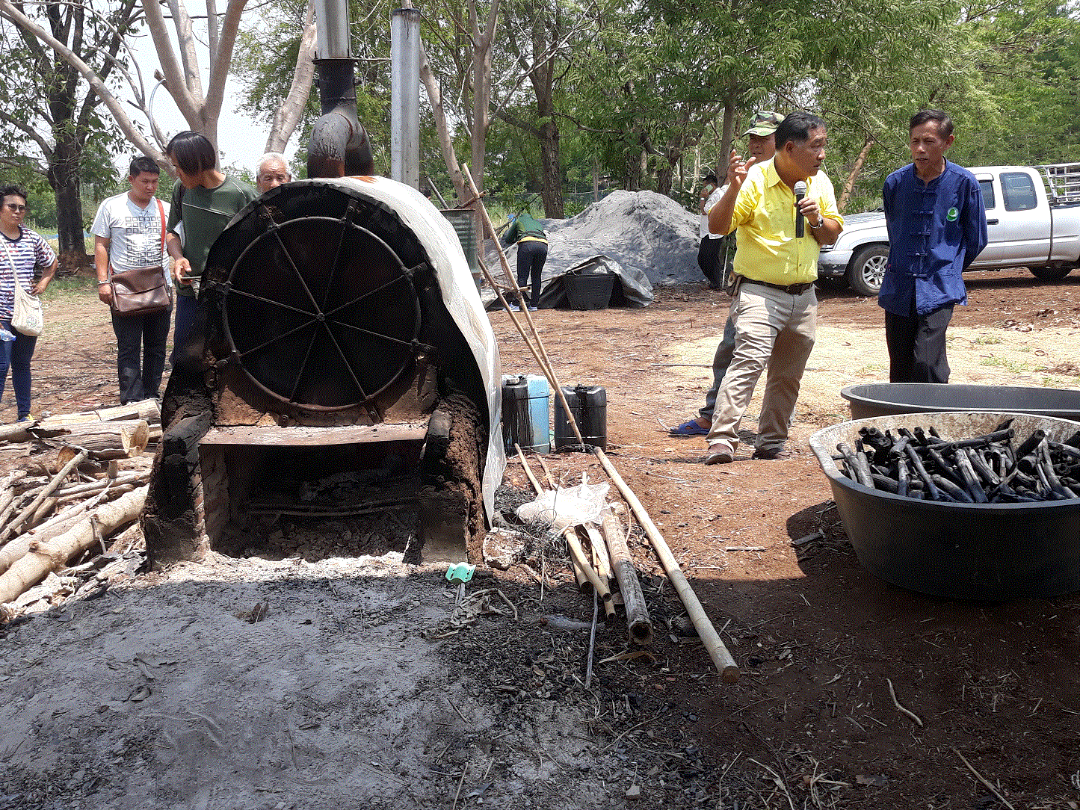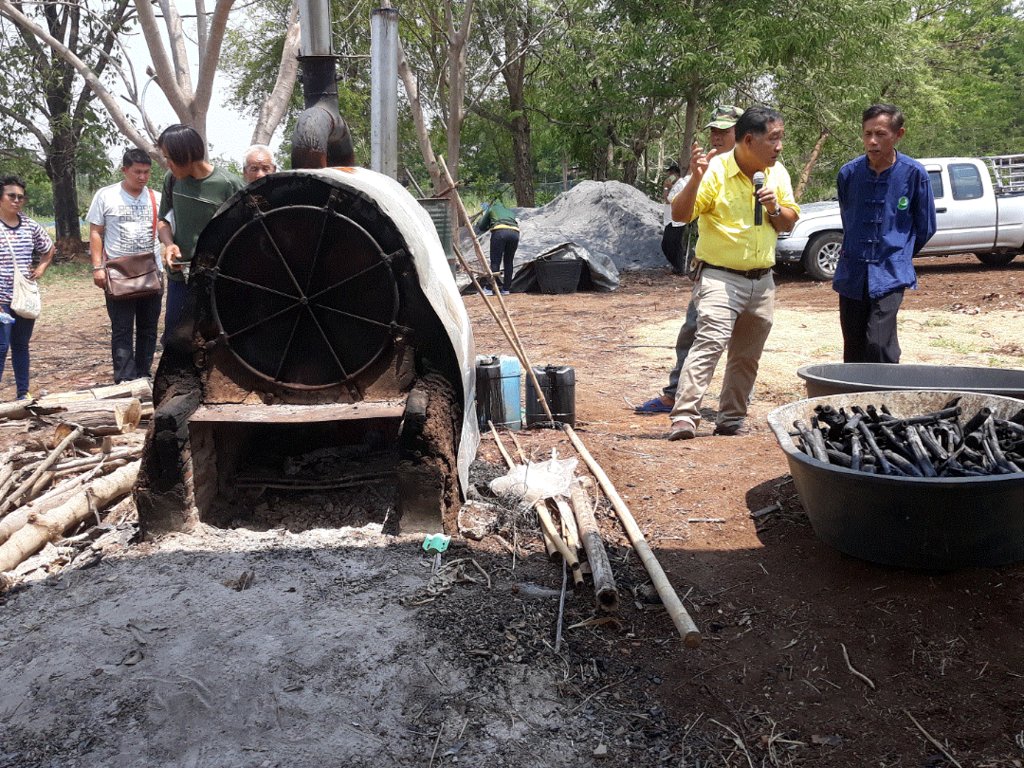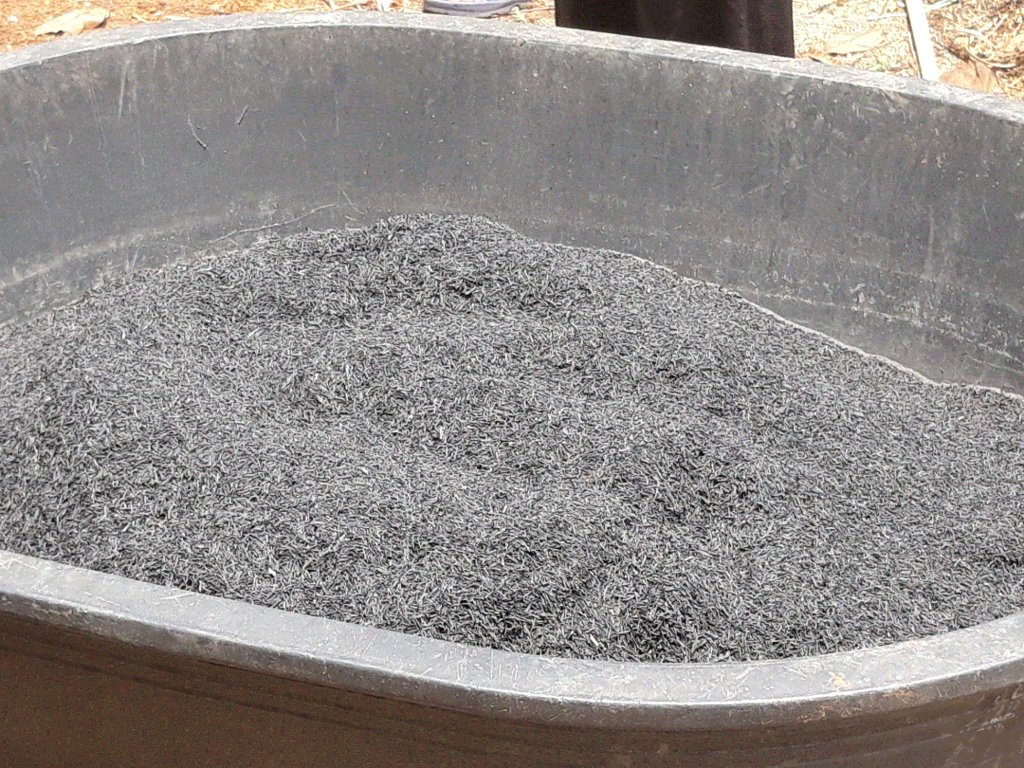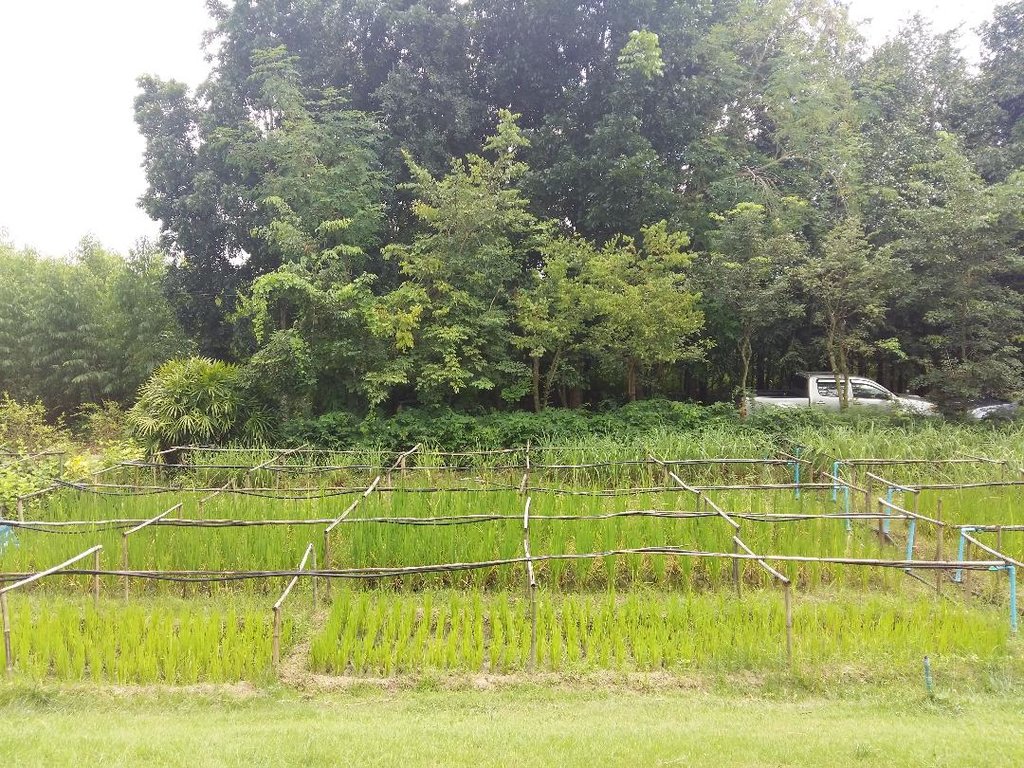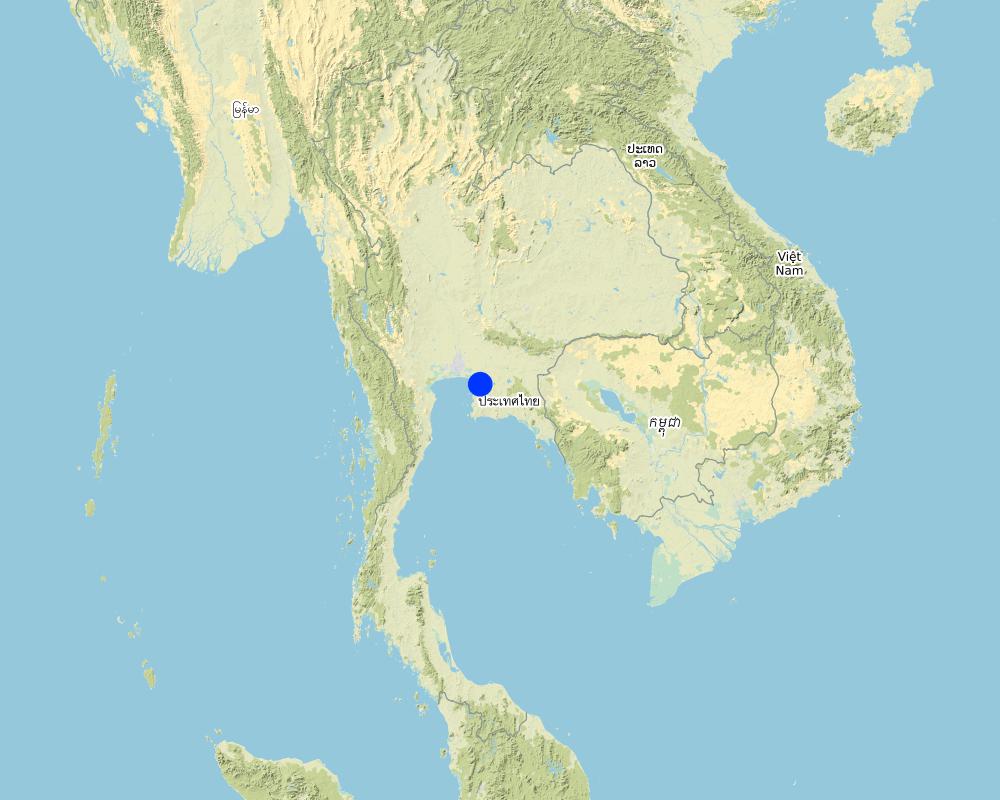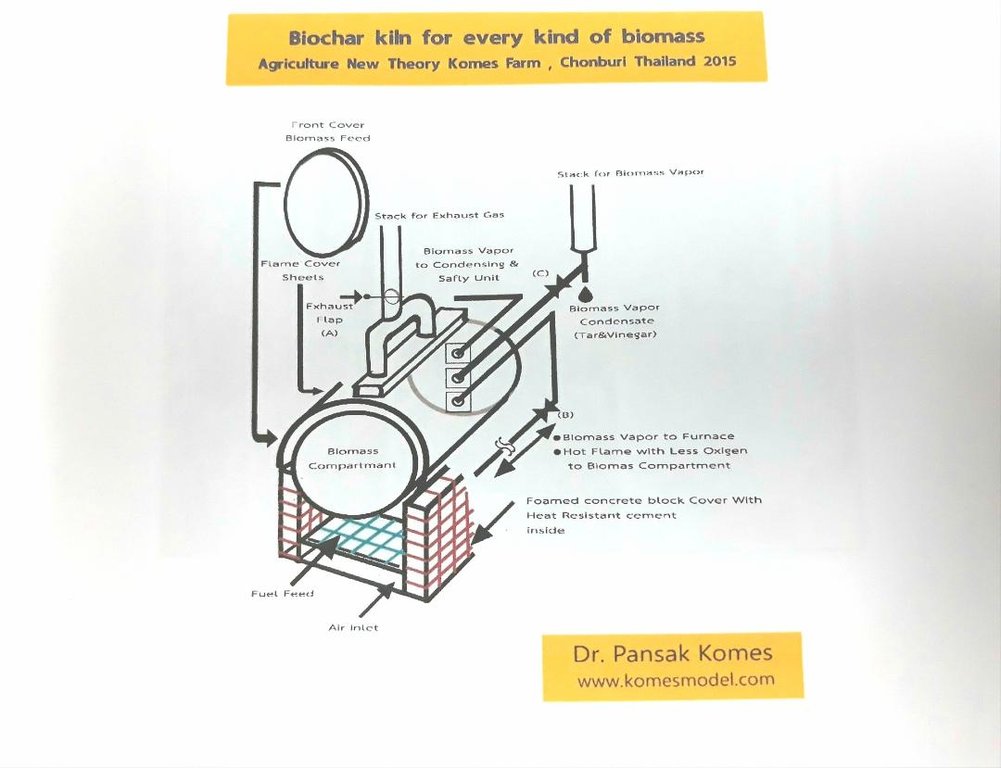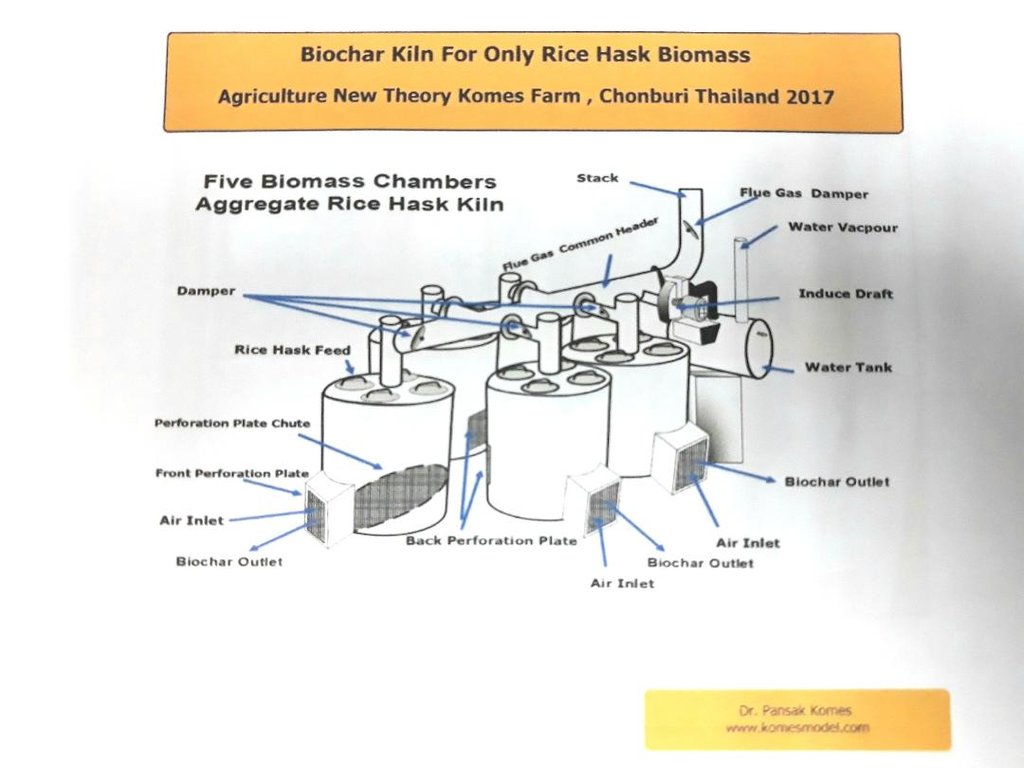Biochar application for land improvement [Thailand]
- Creation:
- Update:
- Compiler: Bunjirtluk Jintaridth
- Editor: –
- Reviewers: Rima Mekdaschi Studer, Pitayakon Limtong, William Critchley
Biochar application for land improvement
technologies_5246 - Thailand
View sections
Expand all Collapse all1. General information
1.2 Contact details of resource persons and institutions involved in the assessment and documentation of the Technology
SLM specialist:
Thomgcomephan Nisuda
Land Development Department
Thailand
land user:
Komes Pansak
Bor Kwang Tong District, Chonburi province
Thailand
SLM specialist:
Chollaket Nunthapop
Land Development Department
Thailand
Name of project which facilitated the documentation/ evaluation of the Technology (if relevant)
Environmental Land Management and Rural Livelihood ProjectName of the institution(s) which facilitated the documentation/ evaluation of the Technology (if relevant)
Wageningen Agric. University (Wageningen Agric. University) - Netherlands1.3 Conditions regarding the use of data documented through WOCAT
The compiler and key resource person(s) accept the conditions regarding the use of data documented through WOCAT:
Ja
1.4 Declaration on sustainability of the described Technology
Is the Technology described here problematic with regard to land degradation, so that it cannot be declared a sustainable land management technology?
Nee
2. Description of the SLM Technology
2.1 Short description of the Technology
Definition of the Technology:
Biological charcoal, or biochar, is porous charcoal obtained from biomass. Biochar as a soil amendment helps improve soil fertility as well as sequestering carbon in the soil.
2.2 Detailed description of the Technology
Description:
Biological charcoal or biochar is porous charcoal obtained from biomass. To obtain biochar, biomass is loaded into a kiln that can be heated to very high temperature (higher than 500 degrees Farenheit). The biomass goes through a process of biodegradation called pyrolysis. After a few hours, this biomass is converted into a coal-like substance, which farmers can use as a soil amendment. Biochar is an alternative way to solve the problems of the environment such as healthy soils, food production and global warming reduction.
Such charcoal production is a technology that can be conducted from the level of farmers to the level of industries. Lehmann and Joseph (2009) collated research work related to the properties of biochar. It was found that biochar had a property of neutrality to alkalinity. It is porous, can hold water and has a composition of elements such as phosphorus, potassium and calcium - but especially carbon. Their findings indicated that biochar can absorb nutrients well, can withstand biological and chemical decomposition and promote activities of microorganisms in the soil. In addition to this biochar, through its positive effect on carbon sequestration, is another way to reduce the emission of carbon to the atmosphere - which is the cause of climate change through the greenhouse effect. Carbon is effectively locked in the biochar and not released. Much research has found that biochar is suitable for agricultural application. It improves soil properties physically, chemically and biologically. To work with biochar, we need a biochar kiln to produce it.
2.3 Photos of the Technology
2.5 Country/ region/ locations where the Technology has been applied and which are covered by this assessment
Country:
Thailand
Region/ State/ Province:
Chonburi province
Further specification of location:
Bor Kwang Tong District, Chonburi province
Specify the spread of the Technology:
- evenly spread over an area
If precise area is not known, indicate approximate area covered:
- 1-10 km2
Is/are the technology site(s) located in a permanently protected area?
Nee
Map
×2.6 Date of implementation
If precise year is not known, indicate approximate date:
- less than 10 years ago (recently)
2.7 Introduction of the Technology
Specify how the Technology was introduced:
- through land users' innovation
3. Classification of the SLM Technology
3.1 Main purpose(s) of the Technology
- improve production
- reduce, prevent, restore land degradation
- conserve ecosystem
- adapt to climate change/ extremes and its impacts
- mitigate climate change and its impacts
3.2 Current land use type(s) where the Technology is applied
Land use mixed within the same land unit:
Ja
Specify mixed land use (crops/ grazing/ trees):
- Agroforestry

Cropland
- Annual cropping
Annual cropping - Specify crops:
- cereals - rice (wetland)
Annual cropping system:
Vegetables - wheat/barley/oat/upland rice
Number of growing seasons per year:
- 2
Is intercropping practiced?
Ja
Is crop rotation practiced?
Ja
3.3 Has land use changed due to the implementation of the Technology?
Has land use changed due to the implementation of the Technology?
- No (Continue with question 3.4)
3.4 Water supply
Water supply for the land on which the Technology is applied:
- mixed rainfed-irrigated
3.5 SLM group to which the Technology belongs
- natural and semi-natural forest management
- agroforestry
- integrated soil fertility management
3.6 SLM measures comprising the Technology

agronomic measures
- A2: Organic matter/ soil fertility
- A6: Residue management
A6: Specify residue management:
A 6.1: burned

vegetative measures
- V1: Tree and shrub cover

management measures
- M6: Waste management (recycling, re-use or reduce)
3.7 Main types of land degradation addressed by the Technology

chemical soil deterioration
- Ca: acidification
- Cp: soil pollution

physical soil deterioration
- Pc: compaction
- Pk: slaking and crusting
- Pi: soil sealing
3.8 Prevention, reduction, or restoration of land degradation
Specify the goal of the Technology with regard to land degradation:
- prevent land degradation
- restore/ rehabilitate severely degraded land
4. Technical specifications, implementation activities, inputs, and costs
4.1 Technical drawing of the Technology
Technical specifications (related to technical drawing):
Biochar kiln for rice husk biomass
Author:
Dr.Pansak Komes
Date:
27/06/2019
4.2 General information regarding the calculation of inputs and costs
Specify how costs and inputs were calculated:
- per Technology unit
Specify unit:
Klin
Specify dimensions of unit (if relevant):
0.6 m * 0.9 m
If relevant, indicate exchange rate from USD to local currency (e.g. 1 USD = 79.9 Brazilian Real): 1 USD =:
31.9
Indicate average wage cost of hired labour per day:
10
4.3 Establishment activities
| Activity | Timing (season) | |
|---|---|---|
| 1. | Biochar application | after harvest crop |
4.4 Costs and inputs needed for establishment
| Specify input | Unit | Quantity | Costs per Unit | Total costs per input | % of costs borne by land users | |
|---|---|---|---|---|---|---|
| Labour | Finding the area to install the set of the biochar-producing stove, make area adjustment for the base plate and the supply line, and the drainage course | person | 10.0 | 35.0 | 350.0 | |
| Labour | Building the shelf for keeping Feed Stock and keeping the biochar | person | 10.0 | 35.0 | 350.0 | |
| Labour | Building the electrical system for using the lighting equipment and Service Water | person | 0.06 | 33.0 | 1.98 | |
| Labour | Building equipment parts of the biochar-producing stove, namely dust & exhaust -trapping equipment and the equipment assembling work, medium-levelled labor | person | 0.86 | 16.6 | 14.28 | |
| Equipment | Building equipment parts of the biochar-producing stove, namely dust & exhaust -trapping equipment and the equipment assembling work, low-levelled labor | person | 0.86 | 35.0 | 30.1 | |
| Equipment | Equipment costs for building biochar-producing stoves(Biochar klin for every kind of biomass together with Biochar klin for only rice husk biomass totalling 1 set),namely 200-liter used tanks, Induce Draft Fan, Electric Water Pump, High pressure water spray, Electric Wood Saw and other miscellaneous equipment | person | 0.03 | 400.0 | 12.0 | |
| Equipment | Costs of materials which are iron ornaments, namely iron pipes, screws-nuts and others totaling 40 items for building the stove for 1 set | person | 0.03 | 599.6 | 17.99 | |
| Total costs for establishment of the Technology | 776.35 | |||||
| Total costs for establishment of the Technology in USD | 24.34 | |||||
4.5 Maintenance/ recurrent activities
| Activity | Timing/ frequency | |
|---|---|---|
| 1. | Cleaning the pipe system and the spray head transferring the heat flame between the combustion chamber and the chamber containing biomass | Every time of the operation for 3 times |
| 2. | Cleaning the perforated metal plate containing biomass in the stove producing biochar from rice husk | Every time of the operation for 3 times |
| 3. | Inspecting defects of the metal exposed to high heat (Hot Spot) | Every year |
| 4. | Major Overhaul | Every 2 years |
| 5. | Inspecting and repairing the equipment trapping dust from exhaust | Every time of the operation for 6 times |
4.6 Costs and inputs needed for maintenance/ recurrent activities (per year)
| Specify input | Unit | Quantity | Costs per Unit | Total costs per input | % of costs borne by land users | |
|---|---|---|---|---|---|---|
| Labour | Preparing Feed Stock , transporting biomass materials and products | person | 0.06 | 2200.0 | 132.0 | |
| Equipment | Miscellaneous equipment and tools for operation | set | 0.03 | 333.3 | 10.0 | |
| Plant material | Firewood scraps can be bought locally(including transportation expenses) | kg | 333.3 | 0.03 | 10.0 | |
| Plant material | Raw rice husk (including transportation expenses) | kg | 333.3 | 0.06 | 20.0 | |
| Other | Yearly Inspection and Maintenance | time | 33.3 | 1.3 | 43.29 | |
| Other | Electrical energy and tap water | time | 3.33 | 3.3 | 10.99 | |
| Total costs for maintenance of the Technology | 226.28 | |||||
| Total costs for maintenance of the Technology in USD | 7.09 | |||||
4.7 Most important factors affecting the costs
Describe the most determinate factors affecting the costs:
construction materials
5. Natural and human environment
5.1 Climate
Annual rainfall
- < 250 mm
- 251-500 mm
- 501-750 mm
- 751-1,000 mm
- 1,001-1,500 mm
- 1,501-2,000 mm
- 2,001-3,000 mm
- 3,001-4,000 mm
- > 4,000 mm
Specifications/ comments on rainfall:
The western part of Chonburi province is adjacent to the coast, making the amount of rain at the coastal areas different from the inland. The coastal area at Muang district has localized downpours and the amount of rain is more than other areas. The total amount of rain throughout the year accounts for more than 1,200 mm. Name of
Indicate the name of the reference meteorological station considered:
weather station: Chonburi Weather Station
Agro-climatic zone
- sub-humid
5.2 Topography
Slopes on average:
- flat (0-2%)
- gentle (3-5%)
- moderate (6-10%)
- rolling (11-15%)
- hilly (16-30%)
- steep (31-60%)
- very steep (>60%)
Landforms:
- plateau/plains
- ridges
- mountain slopes
- hill slopes
- footslopes
- valley floors
Altitudinal zone:
- 0-100 m a.s.l.
- 101-500 m a.s.l.
- 501-1,000 m a.s.l.
- 1,001-1,500 m a.s.l.
- 1,501-2,000 m a.s.l.
- 2,001-2,500 m a.s.l.
- 2,501-3,000 m a.s.l.
- 3,001-4,000 m a.s.l.
- > 4,000 m a.s.l.
Indicate if the Technology is specifically applied in:
- not relevant
5.3 Soils
Soil depth on average:
- very shallow (0-20 cm)
- shallow (21-50 cm)
- moderately deep (51-80 cm)
- deep (81-120 cm)
- very deep (> 120 cm)
Soil texture (topsoil):
- coarse/ light (sandy)
Soil texture (> 20 cm below surface):
- coarse/ light (sandy)
Topsoil organic matter:
- low (<1%)
5.4 Water availability and quality
Ground water table:
on surface
Availability of surface water:
medium
Water quality (untreated):
for agricultural use only (irrigation)
Water quality refers to:
both ground and surface water
Is water salinity a problem?
Nee
Is flooding of the area occurring?
Nee
5.5 Biodiversity
Species diversity:
- high
5.6 Characteristics of land users applying the Technology
Sedentary or nomadic:
- Sedentary
Market orientation of production system:
- mixed (subsistence/ commercial)
Off-farm income:
- 10-50% of all income
Relative level of wealth:
- average
Individuals or groups:
- individual/ household
Level of mechanization:
- manual work
Gender:
- men
Age of land users:
- middle-aged
- elderly
5.7 Average area of land used by land users applying the Technology
- < 0.5 ha
- 0.5-1 ha
- 1-2 ha
- 2-5 ha
- 5-15 ha
- 15-50 ha
- 50-100 ha
- 100-500 ha
- 500-1,000 ha
- 1,000-10,000 ha
- > 10,000 ha
Is this considered small-, medium- or large-scale (referring to local context)?
- medium-scale
5.8 Land ownership, land use rights, and water use rights
Land ownership:
- individual, titled
Land use rights:
- individual
Water use rights:
- individual
Are land use rights based on a traditional legal system?
Ja
5.9 Access to services and infrastructure
health:
- poor
- moderate
- good
education:
- poor
- moderate
- good
technical assistance:
- poor
- moderate
- good
employment (e.g. off-farm):
- poor
- moderate
- good
markets:
- poor
- moderate
- good
energy:
- poor
- moderate
- good
roads and transport:
- poor
- moderate
- good
drinking water and sanitation:
- poor
- moderate
- good
financial services:
- poor
- moderate
- good
- poor
- moderate
- good
6. Impacts and concluding statements
6.1 On-site impacts the Technology has shown
Socio-economic impacts
Production
crop quality
fodder production
product diversity
production area
land management
energy generation
Water availability and quality
irrigation water quality
Socio-cultural impacts
food security/ self-sufficiency
SLM/ land degradation knowledge
Ecological impacts
Water cycle/ runoff
water quantity
Soil
soil moisture
soil cover
soil loss
soil accumulation
soil crusting/ sealing
soil compaction
nutrient cycling/ recharge
salinity
soil organic matter/ below ground C
acidity
Biodiversity: vegetation, animals
Vegetation cover
biomass/ above ground C
plant diversity
6.2 Off-site impacts the Technology has shown
buffering/ filtering capacity
impact of greenhouse gases
6.3 Exposure and sensitivity of the Technology to gradual climate change and climate-related extremes/ disasters (as perceived by land users)
Gradual climate change
Gradual climate change
| Season | increase or decrease | How does the Technology cope with it? | |
|---|---|---|---|
| seasonal temperature | increase | well |
6.4 Cost-benefit analysis
How do the benefits compare with the establishment costs (from land users’ perspective)?
Short-term returns:
slightly positive
Long-term returns:
positive
How do the benefits compare with the maintenance/ recurrent costs (from land users' perspective)?
Short-term returns:
slightly negative
Long-term returns:
slightly negative
6.5 Adoption of the Technology
- 1-10%
Of all those who have adopted the Technology, how many did so spontaneously, i.e. without receiving any material incentives/ payments?
- 11-50%
6.6 Adaptation
Has the Technology been modified recently to adapt to changing conditions?
Ja
Specify adaptation of the Technology (design, material/ species, etc.):
soil organic carbon
6.7 Strengths/ advantages/ opportunities of the Technology
| Strengths/ advantages/ opportunities in the land user’s view |
|---|
| Using agricultural material residues as production factors to help reduce costs and increase more soil fertility |
| There are material residues used as the factor producing biochar in the area |
| Being the learning center of the community |
| Strengths/ advantages/ opportunities in the compiler’s or other key resource person’s view |
|---|
| Inventing and designing materials & equipment producing biochar for industrial production |
6.8 Weaknesses/ disadvantages/ risks of the Technology and ways of overcoming them
| Weaknesses/ disadvantages/ risks in the land user’s view | How can they be overcome? |
|---|---|
| Regarding making materials & equipment for producing biochar, there ae high costs for some smallholders | Aggregation for making materials & equipment for the community |
| Not being able to produce industrially | Inventing and designing materials & equipment producing biochar for industrial production |
| Inventing and designing materials & equipment producing biochar for industrial production | Building a close system in order to manage the smoke, reducing the impact on the environment |
7. References and links
7.1 Methods/ sources of information
- field visits, field surveys
100 persons per year
- interviews with land users
2 persons
- interviews with SLM specialists/ experts
3 persons
When were the data compiled (in the field)?
08/07/2019
7.3 Links to relevant online information
Title/ description:
Biochar application for land improvement
URL:
https://qcat.wocat.net/th/wocat//techno;ogies/view/technologies_4750/
Title/ description:
Effect of Biochar Application on Soil Quality and Soil Carbon Sequestration in Acid Soils
URL:
www.adb.org
Title/ description:
Agriculture new Theory Komes Farm
URL:
www.komesmodel.com
7.4 General comments
Dr.Pansak Komes- SLM expert
Acting Sub - co-complier
Links and modules
Expand all Collapse allLinks
No links
Modules
No modules


